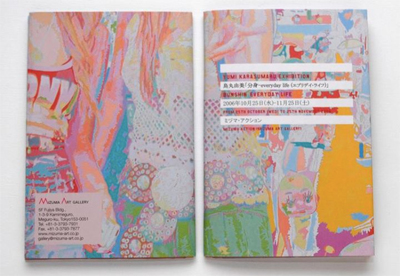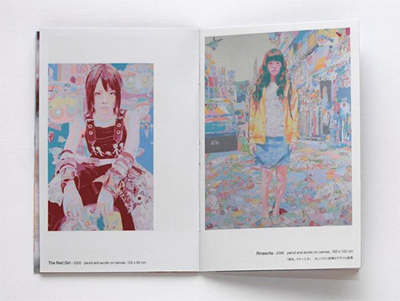From the catalog of the personal exhibition "Bunshin - Everyday Life",
at Mizura Art Gallery, Tokyo, 2006

The Coming of a New Japanese Style (Japonaiserie)
by Takuo Komatsuzaki
Deputy Director - Hiroshima City Museum of Contermporary Art
No matter how large an achievement is made in Japan, there are few artists who can manage to settle in an environment to concentrate on production or show their work as soon as they are abroad. Among those venturing abroad, most are submerged, without any particular achievement or return to Japan in despair, continuing sparsely. Success is a rare case. Nevertheless, many artists head abroad in search for a place for activity. This is a reflection of the japanese art world's situation since the Meiji era in which new returness from abroad were privileged unconditionally, and this tendency remained until a decade or so since World War II whether the destination was Paris or New York. However, this scheme no longer works. Information is shared simultaneously worldwide, and if we only wish to know the latest trends in the art world, anyone can obtain this information almost without any time lag whether in Japan or abroad. Also, groups and organizations with an influence towards the art world and accept returness are already extinct in Japan. Still, young people try to go abroad. There is a certain reason for this. If one stays abroad, there baybe a chance for them to catch the eyes of an influential curator working as commissioner for an international show. Furthermore, the art market is far more large compared to Japan. If chances for success are the same, returns are much bigger abroad. Yet actually, regardless of whether one graduates from art school abroad, the art world ultimately depends on one's ability. Corpses of young spirits with no destination hopelessly overlapping each other - this seems to be the reality. In karasumaru's case, whether in her activities in Italy or shows in Japan, she is free from the ambitious context common to such Japanese artists dreaming of success. She has reached this point groping her way step by step. Karasumaru's works are painting drawn from photographs taken by herself. At first sight, they look like exact copies of digital processed images, but actually they are a collection of remarkably time consuming handwork . analog tracing and meticulous coloring. The finished tableau may not reveal this analog quality so much but looking at her sketches and colored drawings, it is obvious that the soft colored surface with brush strokes belong to the category of so-called painting. Her subjects are japanese high school girls, secondary school students and even younger boys and girls. Laughing carefreely dressed in the latest fashion, they relinquish their bodies to this moment's pleasure and enjoy the present to their hearts' content. We are amazed by the sheer void of their insides and cannot help being boggled at the existence of an appalling emptiness seen beyond their laughter and carefreeness. The artificial and pop colors ignoring reality further emphasize such a sense of bewilderment. Yet the images of these children appearing artificial and extraordinary are true portraits of today's Japan. Ukiyoe, introduced to Europe some time ago embraced a world reflecting Japanese culture. As european sensed in it an immense oriental flavor and spirit completely different from their culture, it quickly diffused as Japanese style (japonaiserie.) Likewise, the acceptance of karasumaru's works in Italy may be for the intense flavor of contemporary Japan imbuing her works and its Japanese style. We can call her works "Neo-Japoneserie" or "Japonaiserie Contemporain". In an age when the significance of Japan and the identity of Japanese are about to be discussed out loudly, we can present lofty self portraits but it is also necessary for us to question how Japan and its culture are seen and valued from others from an objective view. Looking at Karasumaru's works, self portraits of Japanese shouting out such things loudly only look like "yellow monkey" still without humbleness.
新しい日本趣味(ジャポネズリー)の招来
小松﨑拓男 広島市現代美術館副館長
日本で大きな実績を上げていたとしても、海外に出てすぐさま制作に専念できる環境や作品の発表機会を得られたりすることのできるアーティストなど、ほとんどいない。勇躍海外に出たとしても、多くの場合さしたる実績を上げられることもできずに埋もれてしまうか、失意の内に日本に帰国し、細々と制作を続けることになってしまうのではないか。成功するという例は希である。にもかかわらず、多くのアーティストが海外に出て、活動の場を求めようとする。これは明治以来の日本の美術界が外国帰りの新帰朝者を無条件に優遇してきた状況の反映であり、第二次世界大戦後の十数年間ぐらいまでは、パリに行くにせよ、ニューヨークに行くにせよその傾向は続いていた。
しかし、もはやこの図式は通用しない。情報が世界同時的に共有され、日本にいても海外にいても、ただ美術界の最新の動向に触れるのであれば、ほとんど時間差なく誰もが手にすることができるようになるとともに、新帰朝者を受け入れるような美術界に影響力を持つ団体も組織もすでに日本には存在しなくなってしまったからである。にもかかわらず、若い人たちは海外へ出て行こうとする。理由がないわけではない。海外にいれば国際展のコミッショナーなどを務める有力なキュレーターの目に触れるチャンスもあるかもしれない。また、アート・マーケットも日本に比べれば格段に広い。同じ成功のチャンスがあるなら海外の方がその見返りは遙かに大きいからである。だが現実には、海外の美術学校を卒業したところで、結局は実力次第の美術の世界である。若き志の行き場のない死体が累々といったところが実際ではあるまいか。
烏丸の場合、イタリアでの活動にせよ、日本での作品発表にせよ、こうした日本人のアーティストにありがちな、成功を夢見るような野心的な文脈とは無縁である。地道に手探りでここまで辿り着いた。
さて、烏丸の作品は、自分で写した現代日本の風俗に取材した写真から描き起こした絵画作品であるが、一見デジタル処理をされた画像の引き写しにも見えるが、実はアナログ的なトレースと丹念な彩色による途方もない時間をかけた手作業の集積である。出来上がったタブローではそのアナログ感は余り感じることはできないかも知れないが、エスキースや水彩によるドローイングなどを見ると、筆触の残るいわゆる絵画の範疇に入ることがよくわかる。
主題となるのは女子高生であり、中学生やさらに年若い少女たちである。屈託なく笑い、流行のファッションに身を包み、今この瞬間の享楽に身をゆだね、現在を心の行くまで謳歌する。あまりの中身のなさに驚き、またその笑いや無邪気さの向こうに見える、恐るべき虚無の存在にたじろがざるを得ない。現実を無視した人工的でポップな色彩が、こうした唖然とするような感覚をいっそう際立たせる。やや危険な匂いのする少女愛や「オタク」的世界を感じないわけではないが、この少女たちは正真正銘の今の日本であるだろう。
かつてヨーロッパにもたらされた浮世絵には、日本の風俗を写した世界があった。ヨーロッパ人たちは、そこに自分たちの文化とは全く異質な、限りないオリエンタルな香りと精神を嗅ぎ取り、たちまちに日本趣味(ジャポネズリー)として広まった。烏丸の作品が、イタリアで受け入れられたのも、彼女の作品に溢れかえる芬々たる現代日本の香りであり、趣味であるのではあるまいか。これはネオ・ジャポネズリーあるいはジャポネズリー・コンタンポランとでも呼ぶべきものである。
日本とは何か、日本人のアイデンティティが声高に語られようとしている時代が来ているとき、理想の自画像を掲げるのもいいが、他者から日本の文化がどのように見られ、どのように評価されているのか、客観的に問いかけてみることも必要ではないのか。烏丸の作品を眺めていると、こうしたことを声高に叫ぶ日本人の自画像は未だにyellow monkeyでしかないように見えるのだが‥‥‥。
